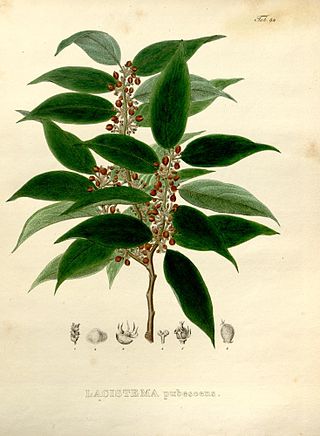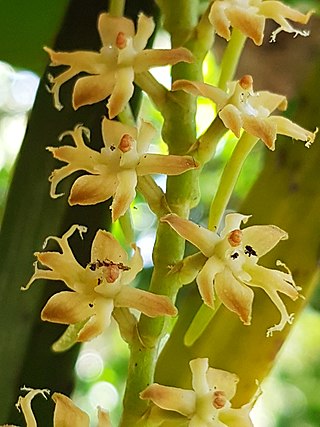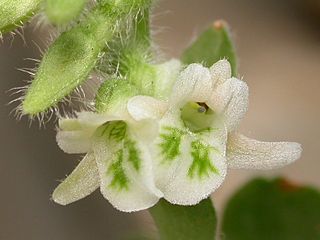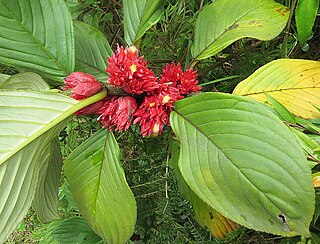
Boesenbergia rotunda, commonly known as Chinese keys, fingerroot, lesser galangal or Chinese ginger, is a medicinal and culinary herb from China and Southeast Asia. In English, the root has traditionally been called fingerroot, because the shape of the rhizome resembles that of fingers growing out of a center piece.

Ticodendron incognitum is the only species of Ticodendron, and the only member of the family Ticodendraceae. It is most closely related to the family Betulaceae.

Columnea is a genus of around 200 species of epiphytic herbs and shrubs in the family Gesneriaceae, native to the tropics of the Americas and the Caribbean. The tubular or oddly shaped flowers are usually large and brightly colored – usually red, yellow, or orange – sometimes resembling a fish in shape. A common name is flying goldfish plants due to the unusual flower shape.

Lacistemataceae is a small flowering plant family. There are two genera:

The citron melon, also called Citrullus lanatus var. citroides and Citrullus amarus, fodder melon, preserving melon, red-seeded citron, jam melon, stock melon, Kalahari melon or tsamma melon, is a relative of the watermelon. It is from the family Cucurbitaceae which consists of various squashes, melons, and gourds. Native to arid landscapes of sub-Saharan Africa, it has been a wild source of nutrition and hydration for humans for an extraordinarily long time. Its fruit has a hard white flesh, rendering it less likely to be eaten raw in the modern era; more often it is pickled or used to make fruit preserves, and is used for cattle feed. It is especially useful for fruit preserves, because it has a high pectin content.

Lacistema is a genus of Lacistemataceae consisting of 12 species :

Lacistema robustum is a species of plant in the Lacistemataceae family. It is endemic to Brazil.

Sievekingia is a genus of orchid, comprising 20 species found in Central and South America, from Nicaragua east to the Guianas and south to Bolivia.

Armando Dugand was a Colombian botanist, geobotanist, and ornithologist.

Tridactyle is a genus of flowering plants from the orchid family, Orchidaceae. It has about 60-70 known species, all native to sub-Saharan Africa.

Lankesterella is a genus of flowering plants from the orchid family, Orchidaceae. It is found mostly in South America, with a few species extending north into Cuba, the Dominican Republic and Costa Rica.
Holistic dentistry, also called biological dentistry, biologic dentistry, alternative dentistry, unconventional dentistry, or biocompatible dentistry, is the equivalent of complementary and alternative medicine for dentistry. Although the holistic dental community is diverse in its practices and approaches, common threads include strong opposition to the use of amalgam in dental fillings, nonsurgical approaches to gum disease, and the belief that root canal treatments may endanger systemic health of the patient through the spread of trapped dental bacteria to the body. Many dentists who use these terms also regard water fluoridation unfavorably.

Holistic nursing is a way of treating and taking care of the patient as a whole body, which involves physical, social, environmental, psychological, cultural and religious factors. There are many theories that support the importance of nurses approaching the patient holistically and education on this is there to support the goal of holistic nursing. The important skill to be used in holistic nursing would be communicating skills with patients and other practitioners. This emphasizes that patients being treated would be treated not only in their body but also their mind and spirit.. Holistic nursing is a nursing speciality concerning the integration of one's mind, body, and spirit with his or her environment. This speciality has a theoretical basis in a few grand nursing theories, most notably the science of unitary human beings, as published by Martha E. Rogers in An Introduction to the Theoretical Basis of Nursing, and the mid-range theory Empowered Holistic Nursing Education, as published by Dr. Katie Love. Holistic nursing has gained recognition by the American Nurses Association (ANA) as a nursing specialty with a defined scope of practice and standards. Holistic nursing focuses on the mind, body, and spirit working together as a whole and how spiritual awareness in nursing can help heal illness. Holistic medicine focuses on maintaining optimum well-being and preventing rather than just treating disease.
Rudolf Mansfeld was a German botanist and agricultural scientist.

Porpax is a genus of epiphytic orchids native to southern and southeastern Asia from India to Yunnan to Borneo. As of March 2021, Plants of the World Online accepts the following species:

Glossoloma is a genus of Neotropical plants in the family Gesneriaceae. The species in the genus were formerly placed in Alloplectus. They are subshrubs with the leaves clustered at the ends of branches, and tubular flowers.
Astronia is a genus of flowering plants belonging to the family Melastomataceae.
Creochiton is a genus of flowering plant belonging to the family Melastomataceae.

Paliavana is a genus of flowering plants belonging to the family Gesneriaceae.
Poikilogyne is a genus of flowering plants belonging to the family Melastomataceae.













